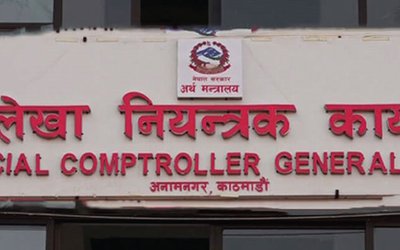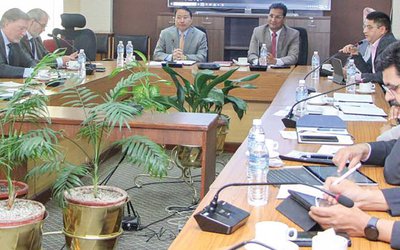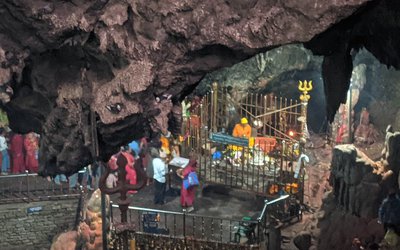12 June 2012, Kathmandu: “Why is it that in this country, those who work the hardest are the poorest?” This question was asked by Shanta Chaudhary at the media meet organised today to mark the World Day Against Child Labour (WDACL) and talk about the situation, progress and challenges in Nepal regarding child labour in Nepal. Chaudhary, a member of the recently disbanded Constituent Assembly and a former kamlari, was shedding light on the plight of those who work the hardest in this country—child labourers.
Chaudhary was one of the panelists at the media meet organised by ILO, UNICEF, World Education and the National Human Rights Commission in cooperation with the Ministry of Labour and Employment.
Chaudhary stressed on the suffering of kamlari (bonded child labourers) and said, “I started working at the age of 8 and continued for 18 years, away from the love and care of the family in the house of a jamindaar (land owner), away from education, away from play and fun. I had to work so much my hands were never dry. My entire childhood, my adolescence, even my motherhood, were all spent as a kamlari.”
She further said that it was a tragedy that children who are made to work double the amount of work than adults, but are paid less than half for the same work. She urged the media to uproot child labour by raiding the homes of powerful people who continue to hire child labour.
Speaking on the occasion, Jose Assalino, Director of ILO in Nepal highlighted the Government’s commitment to eliminate child labour including the ratification of the core child labour Conventions numbers 138 and 182, the establishment of the Child Labour Elimination Section under the Ministry of Labour and Employment and the development of the National Master Plan (NMP, 2011-20). The Master Plan has set priority to eliminate the worst forms of child labour by 2016.
“Child labour is considered to be far too complex to be addressed by the Government in isolation, “ said Assalino “It requires integrated and comprehensive approaches including market measures to promote accelerated economic development and employment creation, effective social protection measures, better education, vocation training and improved labour inspection.”
While highlighting the decisive role of the media in contributing for child labour elimination, he said that media networks and action was crucial in creating “zero tolerance” against child labour and also promoting committed engagement of families, employers’ organizations and trade unions. Assalino also expressed gratitude to the Government of Denmark for its continued support to the elimination of child labour in Nepal.
Krishna Dawadee from the Ministry of Labour and Employment, and Chief of the Child Labour Elimination Section elaborated on the government’s commitment to accelerate activities so as to make the NMP (2011-2020) on child labour a reality. These included using NMP as the instrument to bring coherence amongst various ministries, amongst various laws and legislation that are at odds with each other, to lay more stress on support mechanisms for rural families and to undertake constant analysis.
“We have to be constantly vigilant, for as the country takes more strides towards industrialisation and globalisation, new forms of child labour crop us,” said Dawadee, referring to the mushrooming of zari embroidery in Kathmandu which employs thousands of children working for 16-17 hours a day in horrendous living and working conditions.
Another speaker on the occasion, Dr. Will Parks, Deputy Representative of UNICEF, referring to the complexity of the nature and magnitude of the child labour problem in Nepal said that most often it is the children from the poorest and most marginalized families who are sent to work. “These children face severe violations of their rights. It is children’s right to be children, to be able to grow, study, have fun, in a protective environment,“ he said and added, “Recognising that the same child is often affected by several child protection issues, and that the causes and situations that put a child at risk are the same regardless of the issue, we are working to strengthen child protection systems, rather than addressing specific issues in a fragmented manner.”
Gauri Pradhan, member of the National Human Rights Commission, said that Nepal has made progress on certain fronts regarding child labour, but faced challenges in other fronts. “The numbers of working children under the age of 14 in the country has reduced dramatically, but that the same time the number of children aged 15-17 working in worst forms of child labour has gone up,” he said. “The challenge is to provide educational opportunities to the working children deprived from going to school, and help build up a more skilled and literate young labour force for the future.”
Elaborating on the importance of education, Mr. Chij Kumar Shrestha, Country Director of World Education, said, “There is a need to educate everybody, starting from the parents, that by sending a child out of the door to work as a child labourer, in fact closes many other doors for his or her better future. Free and compulsory education is a must to combat child labour and break the vicious cycle between poverty and child labour.”
The Media Meet was moderated by Kunda Dixit, editor of Nepali Times who urged his media colleagues to treat child labour as an integrated multi-sectoral issue. “This is not just a social issue,“ he said. “It must be looked upon through various lenses, by different beats, whether political, education, health or economy beats.”
The programme concluded with all participants, including the media, signing on a banner that promised to work towards the elimination of child labour in the Nepal. The first signatory was Chaudhary, who had earlier admitted that she picked up her reading and writing skills after becoming a CA member.
- TANAHU HYDROPOWER PROEJCT: A Significant Achievement
- Apr 15, 2024
- AMBASSADOR HANAN GODAR: Sharing Pain With A Nepali Family
- Mar 30, 2024
- VISIT OF KfW AND EIB TO NEPAL : Mission Matters
- Mar 25, 2024
- NEPAL BRITAIN SOCIETY: Pratima Pande's Leadership
- Mar 24, 2024
- NEPAL ARMY DAY: Time To Recall Glory
- Mar 15, 2024
















